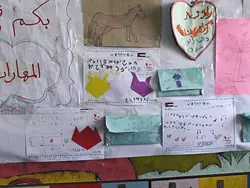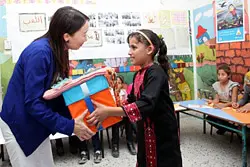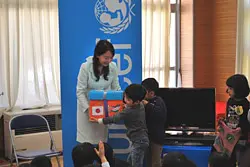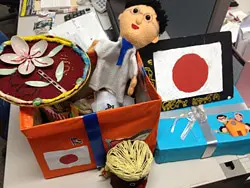



[TOKYO, JAPAN, 8 March 2013]
 |
| Letters that arrived from Palestine last year decorate Horai Kindergarten. |
On 4 March, a total of 29 letters arrived at Horai Kindergarten in Fukushima City from Palestine. The children of Horai Kindergarten began their exchange with Palestinian children in February 2012. Under the Tegami Project, implemented as part of the Japan Committee for UNICEF's (JCU) assistance campaign in response to the Great East Japan Earthquake, letters and pictures were received from children located at the Biadekom Family Centre, which is supported by UNCIEF through funding from Japan.
Following the Great East Japan Earthquake, JCU received over 2,000 letters of support and encouragement to be distributed to children affected by the disaster from children in more than 30 countries and territories. The Tegami Project (https://www.unicef.or.jp/tegami_pj/) was launched as a way to deliver these letters to children in the affected areas and build relationships between the children. Replies from the children at Horai Kindergarten were delivered to children in Palestine in the summer of 2012.
 |
| Letters from Horai Kindergarten on display at Biadekom Family Centre (Palestine). |
The letters delivered to Horai Kindergarten children on this occasion were delivered by JCU Ambassador Agnes Chan following her visit to Palestine in November 2012. On her visit to Palestine, Ms. Chan observed the daily school commute of children. Speaking with JCU, she said that a long wall separates the town and children are required to pass multiple security checkpoints every day. During her stay she visited the Biadekom Family Centre in Gaza Strip, where she spent time with the children who sent the letters. After her visit, Ms. Chan again returned to Japan with letters and presents for the children of Horai Kindergarten.
 |
| ©UNICEF oPt/2012/Pirozzi |
| JCU Ambassador Agnes Chan accepting letters and a present from children in Palestine. |
The letters were translated from Arabic into Japanese and delivered to Horai Kindergarten along with the presents. The children welcomed Ms. Chan by decorating the kindergarten's walls with letters received last year from Palestine, resembling the family centre in Gaza.
Once at the school, Ms. Chan presented the children with the letters and presents passed to her while in Gaza. The box of presents included handmade dolls, flower decorations made from spoons, an embroidered quilt and many other gifts. In their replies to the Fukushima children, the children from Palestine had written out the children's names in English and included messages of encouragement, blessings for good health and happiness, and thank-you notes for their letters. One Palestinian child wrote, "We love all of our friends in Japan."
 |
| Letters and presents arriving at Horai Kindergarten. |
Ambassador Chan read the children a picture book entitled Shukudai (Homework), which she had also read to Palestinian children during her trip. The children listened intently as Ms. Chan read about a teacher who had assigned her students the homework assignment of going home and hugging their family members. At the end of the event, the kindergarten children thanked Ms. Chan with a song, and provided her with origami cranes they had made for their new Palestinian friends.
The Tegami Project has helped to form friendships between children who have all faced, but have overcome, challenges. Through letters, friendship has crossed oceans to blossom between children in disaster and conflict areas.
 |
 |
|
| Letters from Palestine. | Presents from Palestine. |
Tegami Project Website
Click here to read some of the letters received from different countries.

Click here to read about JCU Ambassador Agnes Chan's visit to Palestine.
All photo credits: © Japan Committee for UNICEF